6. If You Had Wings (1972 – 1989) // Buzz Lightyear’s Space Ranger Spin (1998 – Today)
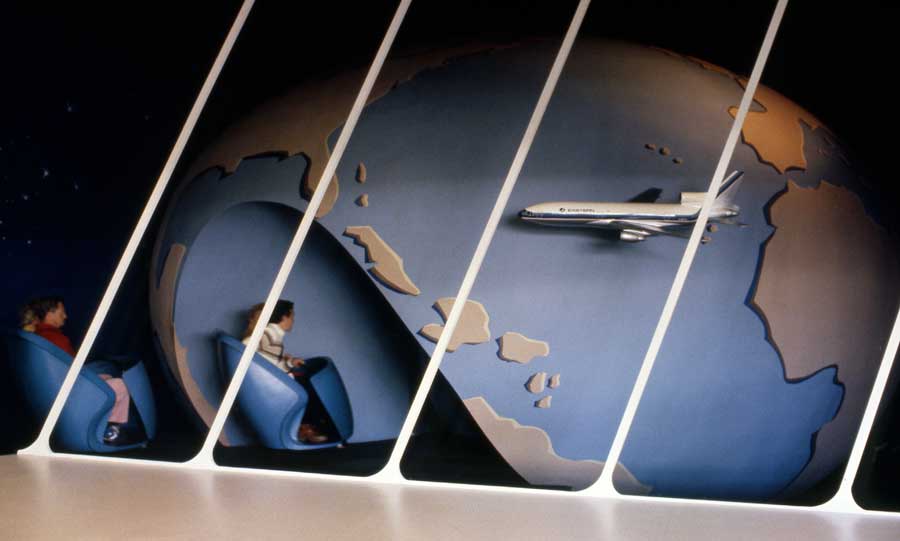
Another mid-century, Tomorrowland-set, early-Omnimover dark ride designed by Claude Coats, it’s no surprise that the Lost Legend: If You Had Wings is sometimes considered a “sister ride” to Adventure Thru Inner Space. Here gliding into a massive globe rather than a microscope, If You Had Wings used physical sets and integrated film projection to showcase destinations served by Disney’s official airline partner, Eastern Air Lines. Set to the tune of an iconic anthem by Buddy Baker, the ride whisked guests to destinations like Puerto Rico, the Bahamas, and New Orleans – all given kinetic energy thanks to cutting edge projection integration.
After Eastern Air Lines folded, If You Had Wings was “de-branded” as If You Could Fly, losing its iconic Buddy Baker song. Soon after, the ride was redesigned as Delta Dreamflight (likewise, later “de-branding” as just Dreamflight) until Tomorrowland’s run of aviation-themed dark rides came to an end thanks to the unexpected success of Toy Story.
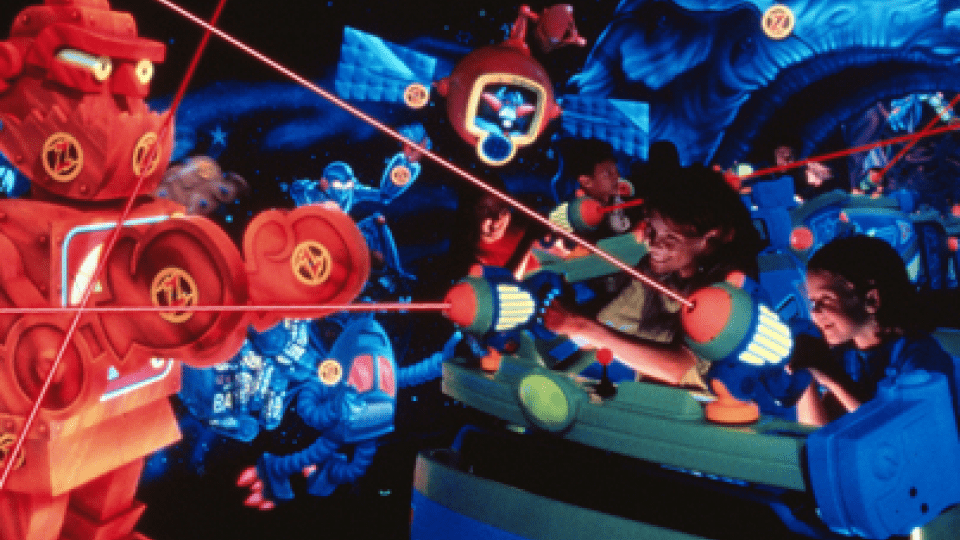
Buzz Lightyear’s Space Ranger Spin was an early step in the “Pixarification” of Disney Parks that we explored in our Member-exclusive Disney•Pixarland Special Feature. Today, of course, the saturated, cartoon colors and glossy, plastic sheen of Star Command are the de facto look of Tomorrowlands, which have largely become character catch-alls. In fact, a Buzz dark ride is one of just three attractions to have been found at every single “Castle Park” on Earth… though two of them have sent Buzz packing to infinity and beyond.
THEN & NOW: If You Had Wings and Buzz Lightyear’s Space Ranger Spin seemingly have few similarities aside from the unchanged track layout. But there’s one element that they share: the “Speed Room.” In 1972, the cutting-edge, ellipsoid-shaped chamber used 70mm projection to surround guests in the motion of airplane take-offs, speedboats, motorcycles, and more that – when combined with an ascending track and wind – created a surprisingly-convincing, disorienting illusion of speed.
Today, it serves as the final showdown with Emperor Zurg, making guests feel that they’re racing through the stars. So even though a Buzz Lightyear dark ride can be found at nearly every Disney Resort, only Magic Kingdom’s uses the inherited Speed Room for such an action-packed finale, making the original ride the most one-of-a-kind.
7. Splash Mountain (1992 – 2023) // Tiana’s Bayou Adventure (2024 – Today)

Most people have never seen Disney’s 1946 film Song of the South. That’s on purpose. A seemingly-permanent resident of the “Disney Vault,” the film has never been released on home video in the U.S. In part, that’s because it depicts a rosy, romantic interpretation of the post-Civil War South, and because its protagonist – the Black sharecropper and storyteller “Uncle Remus” – exhibits traits of the “happy slave” trope, longing for the “simpler times” of yesteryear (in which, presumably, he would’ve been enslaved).
It’s important to note that those controversies were well known in the 1980s, when Disney Legend Tony Baxter drafted plans for a “Zip-a-Dee River Run” musical flume ride. But Disney’s E-Ticket thrill ride would carefully avoid the film’s more problematic Uncle Remus frame story and instead focus on the more agreeable and enduring aspects of the movie: the animated folktales of Br’er Rabbit and the Academy Award-winning songs (like “Zip-a-Dee-Doo-Dah”) that serve as the film’s singalong morality tales.
To be clear, it worked. Millions of riders a year made countless memories aboard Splash Mountain, falling in love with characters, settings, and songs from a movie they’d probably never seen. Splash Mountain was an impressive product of Imagineering, noted for its massive animatronic cast, singalong soundtrack, and of course, its 50-foot plunge down Chickapin Hill into the prickly “Briar Patch.” Elevated in name and position to stand along the “Disney Mountains,” Splash Mountain was a modern classic.
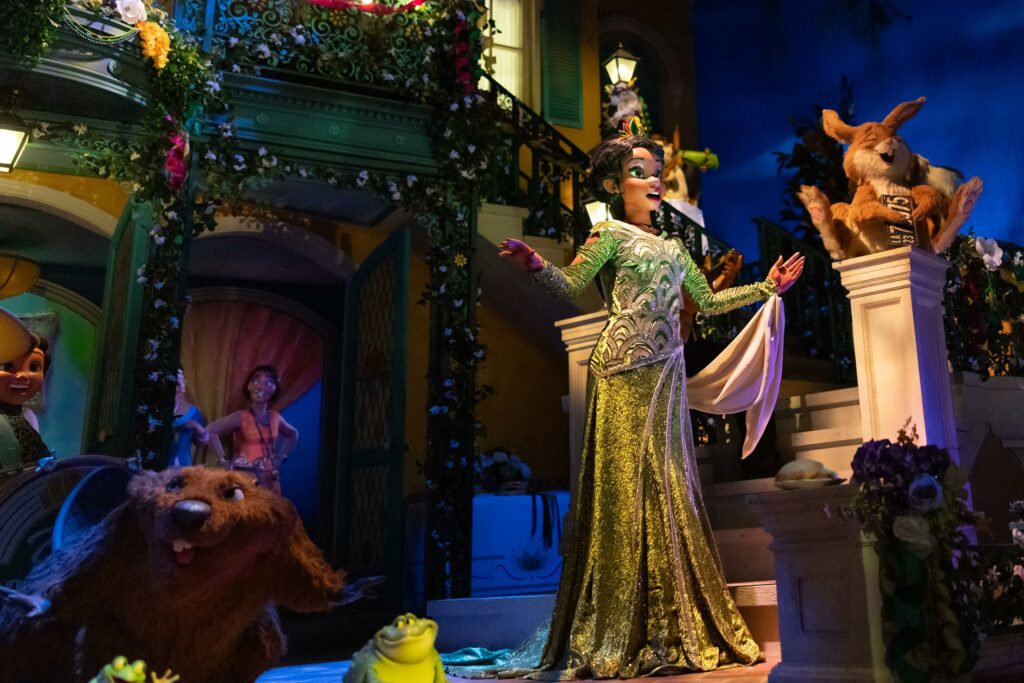
But in the 21st century, The Walt Disney Company began to formalize its efforts to focus on Inclusion. Part of that assessment meant taking a good, hard look at Disney’s theme parks, addressing problematic remnants of the past that perpetuate harmful stereotypes (for example, barbaric depictions of black-skinned “natives” on Jungle Cruise). Splash Mountain was on the short list of “when you know better, you must do better” considerations. And in 2020 – amidst rising societal tensions and the emergence of the “Black Lives Matter” movement – Disney announced a fix.
The ride’s replacement would see Song of the South ousted to make way for 2009’s The Princess and the Frog. Set in the 1920s and Jazz Age New Orleans, this Walt Disney Animation Studios film isn’t just remembered as the movie that began the “Disney Revival” (just as The Little Mermaid had started the “Disney Renaissance” two decades earlier); it also introduced the first Black character into the Disney Princess franchise – the determined, optimistic, would-be restauranteur Tiana.
THEN & NOW: The “Then & Now” look above is of Magic Kingdom’s version of the ride – the first to open in Summer 2024. Swapping red Georgia clay with the flowering ivies, magnolias, and willows of the Louisiana bayou, Splash Mountain was transformed into Tiana’s Bayou Adventure. Though it lost its “Mountain” status in name, the reimagined ride gained a lot, too. Set after the film, the ride sees guests join the staff of Tiana’s Foods – an employee-owned co-op of restauranteurs tutored by Tiana’s successes – drifting off into the bayou to assemble a swingin’ jazz band due to play at a party at Tiana’s Fleur de Bayou manor.
It’s interesting to consider how Imagineers recast the remains of Splash Mountain. Some scenes have equivalent swaps, like the “How Do You Do?” forests of the Briar Patch becoming the firefly-lit bayou, set to the tune of The Princess and the Frog‘s “Gonna Take You There;” the cavernous “Laughin’ Place” has become an underground music club populated by a frog band we’re meant to recruit (with the “coaster dip” into the scene becoming a magic spell by Mama Odie meant to shrink us); and of course, the grand “Zip-a-Dee-Doo-Dah” finale has become a culminating party at Tiana’s home (albeit, using an original song rather than the film’s natural fit – “Down In New Orleans [Finale]”.)
The biggest difference happens on the lift hill up to the ride’s big drop. While fans had daydreamed about the film’s villainous voodoo priest Dr. Facilier and his chanting “Friends on the Other Side” accompanying the tense and terrifying ascent, Imagineers went another way entirely. Perhaps because of their unrelenting allegiance to #story (requiring that the defeated villain not appear in this “sequel”) and perhaps because the film’s stylized form of voodoo is problematic and non-inclusive in its own right, Facilier doesn’t appear at all. Instead, the lift is recontextualized as a magical return to human-size and a shortcut to Tiana’s party, with Mama Odie setting a joyful tone to the plunge.
8. Superstar Limo (2001 – 2002) // Monsters Inc. Mike & Sulley to the Rescue (2006 – Today)
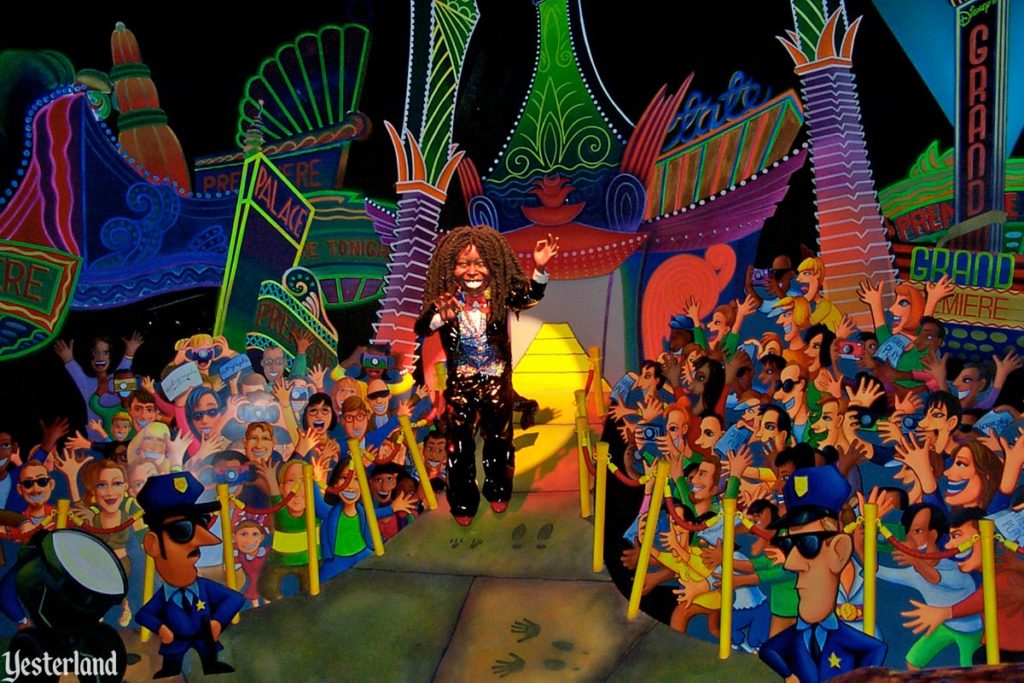
When Disney’s California Adventure opened in 2001, practically no one had anything good to say about the park. But one ride in particular was pretty unanimously recognized as the park’s biggest mistake. Leaning into the “brash,” “edgy,” “Californian attitude” and the “MTV” aesthetic designers hoped would be the park’s signature, the Declassified Disaster: Superstar Limo was an awkward, coarse, hyper-stylized dark ride through Los Angeles neighborhoods with comic book-like sets and caricatured figures of C-list celebrities.
Superstar Limo was so universally reviled that the ride closed before the park’s first birthday – even with nothing planned to replace it. Think about it: that means that executives and Imagineers agreed that California Adventure was stronger with no dark ride at all than with Superstar Limo. The soundstage housing the dark ride sat quietly in a dead-end corner of the park – locked away with lights off – for four years.
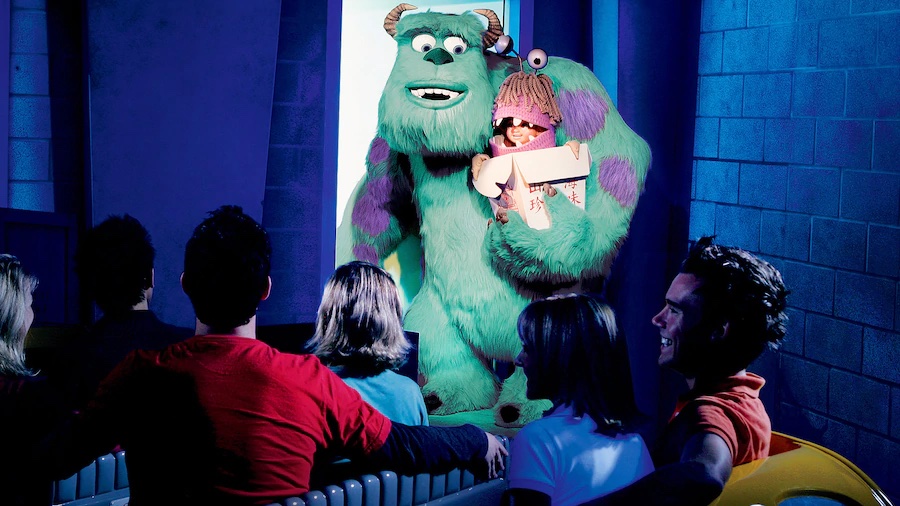
Then, in 2006 – as part of then-President Matt Ouimet’s push to right the wrongs of the preceding decade and return Disneyland to prominence during its 50th Anniversary celebration – Hollywood Pictures Backlot got a new dark ride. Well, not new new…
Monsters Inc. Mike & Sulley to the Rescue finally repurposed the bones of Superstar Limo, turning cartoonish Hollywood limousines into Monstropolis taxi cabs. Sure, it’s just a cute-if-simple “book report” dark ride with some smart staging and clever effects, but it was also a triple threat, giving the young California Adventure much needed family capacity, more Disney characters, and a solution to the Superstar Limo problem.
THEN & NOW: Thankfully, there’s practically no remnant of Superstar Limo to be found in Mike & Sulley to the Rescue aside from the dark ride’s first scene – a “tunnel” wherein in-vehicle video becomes riders’ focus. Especially since Superstar Limo was so staggeringly short-lived, even those who experienced it twenty years ago probably couldn’t feel certain that the layout is unchanged…
Rather than any particular scene or maneuver, the most noteworthy reminder of the building’s former inhabitant is probably a hilarious and widely-known Easter egg: haz-mat suited CDA agents throughout the Monsters Inc. ride just so happen to have the same postures and poses as Superstar Limo’s C-List celebrity stars… Hmm… In any case, this is one “Then & Now” where seeing how Imagineers made use of what they were given actually makes us appreciate the result even more.
9. Merlinwood (1999 – 2008) // Hogsmeade (2010 – Today)

Today, it can be difficult to remember that there was a Universal Orlando before The Wizarding World of Harry Potter. But it’s true; the very spot upon which Hogsmeade resides was originally part of the Lost Legend: The Lost Continent – the “island” that brought to life literary myths, legends, and fables. The Lost Continent was made up of three distinct sub-sections, with the largest being Merlinwood – a mossy, forested Medieval hamlet of cottages and shoppes built around the gnarled Enchanted Oak Tavern.
Though the village itself was relatively small, an iconic portal between carved stone dragons would lead guests along a forested hill to the ruins of a castle. There resided the Lost Continent’s anchor (and one of the park’s headlining stars): Dueling Dragons – a set of intertwined B&M inverted coasters that “dueled,” clashing in three iconic, near-miss maneuvers along the rides’ courses. (The Flying Unicorn – an off-the-shelf family coaster – opened the following year as part of an effort to add more family capacity to the thrill-focused second gate, serving as the last major, IP-free attraction added to the park.)
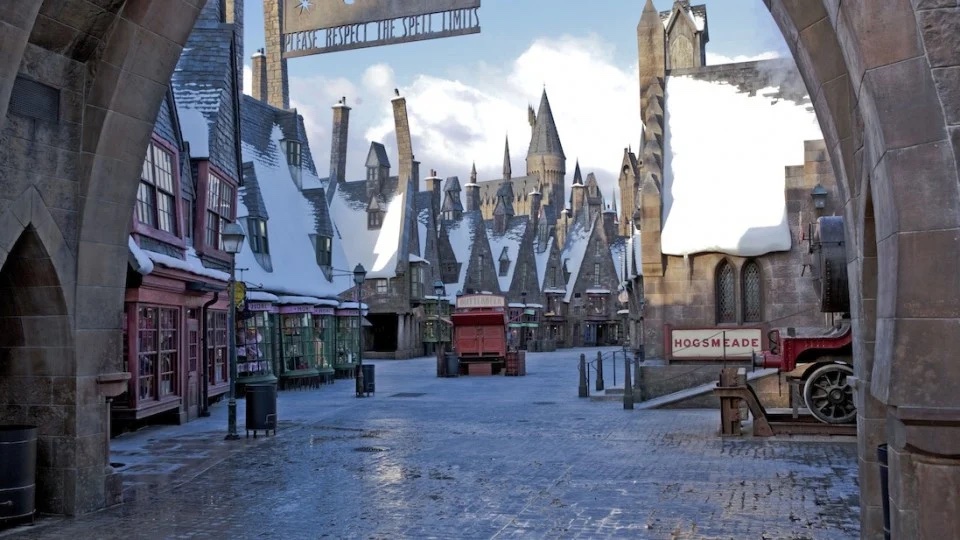
Obviously, the 2010 opening of the Wizarding World of Harry Potter changed Universal Orlando (and the entire themed entertainment industry) forever. That year saw Harry Potter and the Forbidden Journey – a uniquely high-tech dark ride – set down on a formerly-vacant and luckily-placed expansion pad. In 2014, the Hogwarts Express – Hogsmeade Station opened in conjunction with the debut of Diagon Alley. All the while, the Dragons raced on, grandfathered into the land despite the loud, colorful, bare steel coasters being observably out of place among the land’s otherwise immersive landscape.
Finally in 2017, the Dragons were felled in favor of 2019’s Hagrid’s Magical Creatures Motorbike Adventure – still a bare steel coaster, but a much less intrusive and more Wizarding World-appropriate ride, creating the current Hogsmeade diagrammed below. Given how much pomp and circumstances surrounds Hogsmeade – and what a monumental shift it represents for the entire industry – it’s pretty wild to consider just how compact the land is…
THEN & NOW: The surprising truth is that nearly all of Merlinwood still exists – largely unchanged! – beneath the grafted-on Hogsmeade Village. Aside from new trains, the addition of Hagrid’s hut, a new name, and a bowing Hippogriff animatronic, the land’s family coaster hasn’t moved an inch. Likewise, though the route through it and the decorations within it are heavily modified, Hagrid’s Motorbike Adventure reuses the same queue building as Dueling Dragons… and even includes an Easter egg to its predecessor.
Meanwhile, the kitchen, patio, and bar of the Enchanted Oak Tavern remain, just serving the Three Broomsticks and Hog’s Head Pub instead… and without a doubt, doing a lot more business as part of the Wizarding World than they ever did as part of an Arthurian legend. To that end, nearly any other available space from Merlinwood was ceded to Hogsmeade as added retail needed to bring the land to life…
… Which meant that when it was time to expand the Wizarding World, a major closure was needed across the resort at Universal Studios Florida… Read on…



This is awesome!
Great job. Very interesting site. Thank you for making and sharing this.